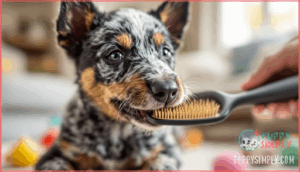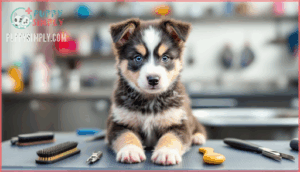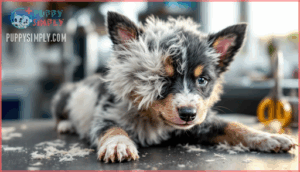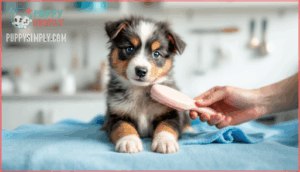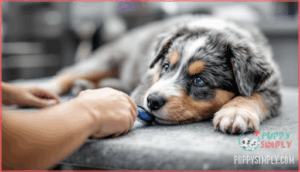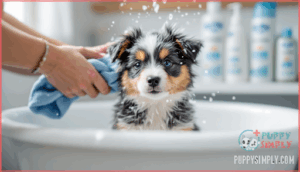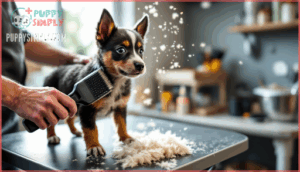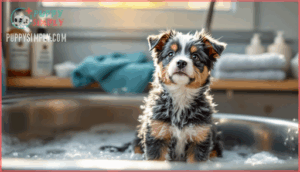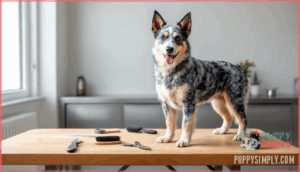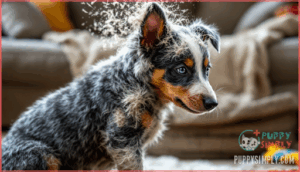This site is supported by our readers. We may earn a commission, at no cost to you, if you purchase through links.
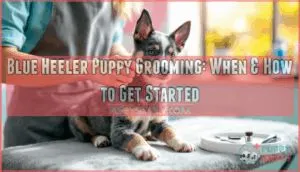
Their fur sheds naturally instead of growing long, which means your grooming focus shifts from scissors to brushes.
What these puppies do need, though, is early exposure to grooming tools and acclimation around 12 to 14 weeks old. Starting young with brushing sessions and nail trims sets the foundation for a lifetime of stress-free maintenance, helping your puppy accept grooming as part of their routine rather than something to fear.
Table Of Contents
- Key Takeaways
- When Do Blue Heeler Puppies Need Haircuts?
- Do Blue Heelers Require Haircuts at All?
- First Professional Grooming for Blue Heelers
- Timing of The Puppy Coat Transition
- Establishing a Grooming Routine Early
- Essential Grooming Tasks for Blue Heeler Puppies
- Managing Shedding During Growth
- Supporting Healthy Skin and Coat in Puppies
- Adult Blue Heeler Grooming Requirements
- Signs Your Blue Heeler Puppy Needs Grooming Help
- Frequently Asked Questions (FAQs)
- When should I introduce brushing and handling exercises before the first haircut?
- What signs of skin irritation or allergies should I watch out for after grooming?
- What age should blue heelers start obedience training?
- Can blue heelers tolerate cold weather climates?
- How much daily exercise do blue heelers need?
- Are blue heelers good with young children?
- What are common behavioral problems in blue heelers?
- Conclusion
Key Takeaways
- Blue Heelers never need haircuts because their short double coat sheds naturally rather than growing long, so your grooming focus should be on regular brushing and de-shedding instead of trimming.
- Start grooming exposure around 12 to 14 weeks old (after vaccinations) to build trust and reduce anxiety, since puppies introduced to grooming before 16 weeks show significantly lower stress during future sessions.
- The puppy coat sheds heavily between 4 to 6 months old during the transition to adult coat, requiring daily brushing during this peak period to manage the dramatic increase in loose fur.
- Weekly brushing with a de-shedding brush and bathing every 6 to 8 weeks maintains coat health without stripping natural oils, while over-bathing or skipping brushing can cause skin issues and excessive household shedding.
When Do Blue Heeler Puppies Need Haircuts?
Blue heeler puppies don’t actually need haircuts the way long-haired breeds do—their short double coat is designed to shed rather than grow continuously. But that doesn’t mean grooming isn’t important during their first months.
Understanding what your puppy’s coat needs at different stages helps you keep them comfortable and healthy while they’re still growing.
Typical Grooming Timeline for Puppies
Your blue heeler puppy won’t need a full haircut in the early weeks, but establishing a grooming routine from the start sets them up for a lifetime of easy care at the groomer’s chair. Most puppies benefit from their initial grooming at around 12 to 14 weeks, after core vaccinations are complete. This vaccination-grooming link matters because their immune systems need protection first.
During this sensitive interaction period, gentle introductions to home grooming tools—brushing, nail clippers, and ear cleaning—help your blue heeler puppy acclimate without fear. Breed-specific needs mean focusing on their short double coat through consistent brushing rather than trims.
Early puppy development during these first months is critical; puppies exposed to grooming before 16 weeks show considerably lower anxiety later.
Puppies exposed to grooming before 16 weeks show significantly lower anxiety in future grooming sessions
Coat Type and Haircut Necessity
Here’s the thing—blue heelers have a short, dense double coat that doesn’t need haircuts the way longer-haired breeds do, but that doesn’t mean you can skip grooming altogether. Their coat type sheds year-round and heavily seasonally, so your grooming routine focuses on brushing and de-shedding rather than trimming.
Staying on top of shedding patterns keeps their coat healthy and reduces loose fur around your home. Breed standards for blue heelers expect that natural short coat, so maintenance beats trims.
Do Blue Heelers Require Haircuts at All?
Blue heelers have short, dense coats that are built for durability, not for show. Unlike long-haired breeds that need regular trims to stay healthy and comfortable, your blue heeler puppy won’t require haircuts in the traditional sense.
Instead, you’ll focus on coat maintenance and managing shedding through brushing and other grooming essentials.
Differences From Long-Haired Breeds
Unlike long-haired breeds that need regular trims every six to eight weeks, blue heelers don’t actually require haircuts at all. Their short, dense double coats are self-maintaining and designed to shed naturally rather than mat. Here’s what sets them apart:
- Coat structure: Blue heelers have outer hair up to 1.5 inches long versus long-haired breeds exceeding 2 inches, reducing matting risk considerably
- Grooming focus: You’ll brush and manage undercoat instead of trimming, unlike the monthly maintenance long-haired dogs demand
- Shedding visibility: Their short hair penetrates fabrics more than long-haired clumps, but it sheds naturally without trapping dead fur
- Professional care: Blue heelers need twice-yearly de-shedding treatments, while long-haired breeds require frequent specialized trimming and mat removal
- Cost difference: Annual grooming expenses for long-haired breeds run 30–50% higher due to increased service complexity
This breed comparison shows your blue heeler’s grooming needs are fundamentally different—simpler and more affordable.
Short-haired breeds benefit from weekly brushing routines to remove dead hair and distribute skin oils.
Coat Maintenance Vs. Trimming
So here’s the thing—maintenance and trimming are two completely different jobs, and understanding that difference will save you time and money with your blue heeler.
Maintenance means regular brushing to manage shedding and keep their double coat healthy. You’re not cutting hair; you’re removing dead undercoat with the right grooming tools.
Trimming means actually shortening the coat—something your blue heeler simply doesn’t need.
Focus your DIY grooming efforts on brushing several times weekly, especially during shedding season, to support coat health and breed standards. That’s your real job as an owner.
First Professional Grooming for Blue Heelers
Getting your blue heeler puppy to a groomer for the first time is an important step, and timing matters more than you might think. The earlier you introduce your pup to professional grooming, the easier it’ll be for them down the road.
Here’s what you need to know to set your puppy up for success.
Recommended Age for First Grooming Visit
Getting your blue heeler puppy on a grooming schedule early makes a real difference—and the ideal time for that first professional visit is around 12 to 14 weeks old, right after they’ve completed their core vaccinations. This timing finds an ideal balance where your puppy’s immune system is ready and they’re still in that critical socialization window.
Starting grooming at this age also sets breed standards expectations and helps shape your puppy’s temperament around interaction. Your breeder can offer advice on local groomers who understand blue heeler puppy care, making the whole dog grooming routine feel less intimidating for your pup.
Introducing Puppies to Grooming Tools
Before you bring your blue heeler puppy to a groomer, it’s worth getting them used to the tools and touch at home—it’ll make that first professional visit way less stressful for both of you. Start with a gentle introduction to brushes and clippers during playtime, letting your puppy sniff and explore them.
Build positive associations by pairing tool desensitization with treats and praise. Touch their paws, ears, and face regularly so careful interaction feels normal.
This gradual exposure to your blue heeler puppy care routine strengthens their confidence and makes grooming a natural part of their puppy development.
Timing of The Puppy Coat Transition
Your Blue Heeler puppy’s coat is going to change dramatically as they grow, and knowing when to expect this shift makes grooming way easier.
The puppy coat they’re born with won’t last forever—it’ll shed out and be replaced by their adult coat over a specific timeline. Understanding this shift period helps you stay on top of shedding and keep your puppy comfortable during the process.
When Blue Heeler Puppy Coat Sheds
Your Blue Heeler puppy’s coat shift is one of the most dramatic changes you’ll witness during their first year. Shedding onset usually happens between 4 and 6 months of age, though it can range from 12 weeks to 1 year depending on the individual pup. Here’s what to expect:
- Initial color development appears around 6 to 8 weeks
- Puppy coat shedding intensifies greatly between 4 and 6 months
- Adult coat coloration continues darkening through 4 to 5 months
- Ticking and mottling patterns become distinct during growth
- Shedding intensity varies based on genetics, not seasonal factors
During this coat shift, you’ll notice substantial fur clumps despite their short length. Their double coat density means real volume comes loose. Even though Blue Heelers shed less visibly than long-haired breeds, the amount can surprise you. This isn’t abnormal—it’s simply your pup trading their puppy coat for their permanent adult one. Blue Heelers have a distinct double coat that contributes to their shedding patterns.
Duration of Coat Transition Period
This shift doesn’t happen overnight—the whole process usually stretches across several months, and understanding the timeline helps you stay on top of grooming needs.
Most Blue Heelers complete their coat change between 12 and 18 months old, though some take up to 2 years. Peak shedding happens around 4 to 6 months when that puppy coat really lets loose. You’ll see the most dramatic shift in shedding volume during this window—your pup’s double coat density means serious fur clumps come out despite their short length.
| Age Range | What’s Happening | Grooming Focus |
|---|---|---|
| 4-6 months | Peak shedding, texture changes begin | Daily brushing essential |
| 6-12 months | Coat texture shifts, coloring deepens | De-shedding tools essential |
| 12-18 months | Adult coat solidifies, shedding normalizes | Maintenance brushing routine |
| 18-24 months | Breed-specific timing completes, full adult coat | Weekly brushing sustains |
| 2+ years | Stable double coat, year-round shedding | Consistent grooming schedule |
That’s why brushing during breed-specific timing matters—you’re managing shift shedding volume before it becomes problematic. Nutritional impact on coat health also plays a role, so quality food aids a smoother coat change throughout growth.
Establishing a Grooming Routine Early
Getting your Blue Heeler puppy comfortable with grooming early makes a huge difference down the road. When you start touching their paws, ears, and coat when they’re young, you’re building trust and making future grooming sessions way less stressful for both of you.
Here’s what you need to know to set up a routine that works.
Benefits of Early Grooming Exposure
When you start grooming your Blue Heeler puppy early, you’re not just brushing their coat—you’re teaching them that physical contact is safe and normal. This early exposure builds trust between you and your pup. Regular brushing sessions let them get comfortable with grooming tools and touch.
Puppies introduced to grooming before 16 weeks show considerably lower anxiety during future sessions. You’re creating positive associations that’ll make coat acclimation smoother as they grow, making nail trims, ear cleaning, and baths easier tasks down the road.
Reducing Anxiety Around Grooming
Your puppy doesn’t have to dread the grooming table—the trick is making those early sessions feel like playtime, not punishment. Keep things short and sweet at first. Use calming techniques like gentle praise and treats during grooming. This builds positive associations your Blue Heeler will remember.
- Start with 5-minute sessions to prevent overwhelm and keep grooming feeling manageable
- Use a safe environment where your puppy feels secure and can’t escape or get injured
- Introduce grooming tools slowly—let them sniff the brush before you use it on their coat
- Consider professional help early if your puppy shows real fear, since trainers can teach you specialized techniques
Essential Grooming Tasks for Blue Heeler Puppies
Now that your puppy is home, it’s time to focus on the core grooming tasks that’ll keep their coat and skin healthy. These aren’t complicated, but they do need to happen regularly to prevent problems down the road.
Here’s what you’ll need to tackle as part of your routine.
Brushing and De-shedding
If you’ve got a blue heeler puppy, regular brushing is going to be your best friend for keeping that coat under control. Start with a quality de-shedding brush two to three times weekly. This grooming tool removes loose fur before it ends up everywhere, supporting coat health and reducing shedding frequency.
As your Australian Cattle Dog grows, you’ll notice heavier shedding during seasonal changes. A de-shedding brush manages this better than standard brushes. Consistent grooming also helps your puppy get comfortable with being touched, making future grooming sessions easier on both of you.
Nail Trimming and Ear Cleaning
Now that you’ve got the brushing down, keeping those nails trimmed and ears clean becomes just as important for your growing pup. Start nail trimming early—introduce your puppy to nail clipping tools and paw touching around 8-12 weeks so they’re comfortable with the process. Trim nails every 3-4 weeks to prevent overgrowth and discomfort.
For ear cleaning, use a vet-approved ear cleaning solution weekly to prevent infection. Gently wipe the inner ear with a pet-safe wipe, checking for redness or odor.
Consistent grooming and cleaning frequency now sets your blue heeler up for stress-free maintenance as an adult.
Bathing Frequency Guidelines
Bathing your blue heeler puppy doesn’t need to happen as often as you might think—in fact, too many baths can actually strip away the natural oils their coat needs to stay healthy. Aim for a bath every 6-8 weeks unless your pup gets dirty. Puppy skin sensitivity means you’ll want dog-specific shampoo that’s gentle. Watch for seasonal bathing needs during heavy shedding periods. Over-bathing risks create dry, itchy skin, so stick to this schedule for odor control without overdoing it.
- Bathe every 6-8 weeks under normal conditions
- Use gentle, dog-specific grooming products for puppy skin sensitivity
- Increase frequency during seasonal shedding if needed for odor control
- Avoid over-bathing to protect natural coat oils and skin health
Managing Shedding During Growth
Blue heeler puppies shed year-round, but you’ll notice a big uptick during their coat change and care. Managing this shedding takes the right approach and tools to keep loose fur under control.
Here’s what you need to know about care as your puppy grows.
Seasonal Vs. Year-Round Shedding
Blue Heelers shed consistently throughout the year, but you’ll notice their coat kicks into overdrive twice annually when the seasons shift. Spring and fall bring heavier shedding as your pup trades its coat for weather-appropriate coverage.
Climate impact plays a role too—indoor heating and cooling can blur these cycles. Regular brushing with a deshedding brush keeps shedding manageable and helps you stay ahead of the mess during peak times.
Tools for Effective Shedding Control
The right tools make the difference between chasing fur tumbleweeds around your house and actually controlling the shed. Your Blue Heeler grooming kit should include:
- Deshedding brush – reaches the undercoat where loose fur hides
- Rubber grooming glove – captures surface shedding during bonding time
- Slicker brush – smooths the topcoat and removes debris
- Undercoat rake – confronts dense fur during heavy shedding seasons
These tools help you stay ahead of your Blue Heeler’s year-round shedding cycle.
Supporting Healthy Skin and Coat in Puppies
A healthy coat starts from the inside out, and what you feed your Blue Heeler puppy matters just as much as how you groom them. The right nutrition and bathing products work together to keep their skin calm and their coat shiny.
Here’s what you need to focus on to support your puppy’s developing coat.
Nutrition’s Role in Coat Health
Good dog nutrition starts from the inside out—what your Blue Heeler puppy eats directly shapes coat health. Protein quality builds keratin for shine, while fatty acids keep skin hydrated and reduce inflammation. Vitamins like A, E, and B-complex support follicle strength, and minerals like zinc aid continuous growth.
Allergy response improves when you avoid fillers and processed ingredients.
Hydration levels matter too—proper water intake maintains elasticity and prevents dryness during grooming and coat care routines.
Bathing Products for Sensitive Puppy Skin
Choosing gentle, pH-balanced shampoos designed for puppies protects delicate skin while keeping your Blue Heeler’s coat clean and healthy. Look for hypoallergenic shampoos with tearless formulas to avoid eye irritation during bath time.
Oatmeal baths soothe itchy skin, while puppy conditioners add moisture without stripping natural oils.
If your vet recommends medicated shampoos for specific skin issues, use them as directed alongside your regular grooming and pet care routine.
Adult Blue Heeler Grooming Requirements
Once your Blue Heeler reaches adulthood, grooming becomes more about consistency than complexity. Their short, weather-resistant coat doesn’t demand daily attention, but it does need regular upkeep to stay healthy and manageable.
Here’s what you’ll need to focus on as your pup matures.
Weekly Brushing Needs
Once your Blue Heeler hits adulthood, brushing becomes a weekly commitment you can’t skip. Their double coat sheds year-round, and regular brushing keeps shedding under control while supporting coat health. A quality de-shedding brush makes the job easier and keeps your Blue Heeler comfortable during grooming sessions.
Here’s what weekly brushing does:
- Removes loose fur before it lands on your furniture
- Distributes natural oils for a healthier coat
- Gives you a chance to check for skin issues or irritation
- Strengthens the bond between you and your dog
Occasional Bathing and Maintenance
Your Blue Heeler doesn’t need a bath every week—overdoing it strips the natural oils that keep their coat weather-resistant and healthy. Aim for bathing every 6-8 weeks, adjusting based on your dog’s activities and skin sensitivity.
Choose a gentle, dog-safe shampoo that won’t dry out their skin. After bathing, towel-dry thoroughly and check for any irritation during post-bath care.
Regular grooming between baths keeps your Blue Heeler looking sharp without compromising their coat’s natural protection.
Signs Your Blue Heeler Puppy Needs Grooming Help
Most Blue Heeler puppies do well with at-home grooming, but there are times when you’ll need to step in or call for backup. Learning to spot the warning signs early keeps your puppy comfortable and prevents small issues from turning into bigger problems. Here’s what to watch for as your puppy grows.
Mats, Tangles, and Skin Issues
Even though Blue Heelers don’t need traditional haircuts, their short coat can still develop problems if you’re not staying on top of regular brushing. Watch for tangles behind the ears or along the hindquarters—identifying tangles early prevents mats from forming.
Look for red patches, excessive scratching, or hot spots that signal puppy dermatitis or skin infections. Allergy symptoms like constant licking also warrant attention, as proper shedding management for dogs and skin care protect your pup’s health and coat type.
When to Consult a Professional Groomer
If you notice signs like persistent odors even after bathing, overgrown nails clicking on floors, trapped debris stuck in the coat, or skin irritation with redness and flaking, it’s time to book a professional groomer.
For Blue Heeler puppy training and grooming Australian Cattle Dogs, experts recommend:
- Scheduling visits every 6-8 weeks for thorough coat health assessments
- Professional nail trimming every 3-4 weeks to prevent mobility issues
- Deep de-shedding treatments during seasonal shedding phases
- Early detection of lumps, parasites, or ear infections
- Specialized dog grooming tools that work with thick double coats effectively
Frequently Asked Questions (FAQs)
When should I introduce brushing and handling exercises before the first haircut?
Start brushing your Blue Heeler puppy around 8 weeks old, right when you bring them home. Short sessions using positive reinforcement methods help with desensitization techniques.
Early interaction benefits include reduced grooming anxiety later, making your puppy training smoother overall.
What signs of skin irritation or allergies should I watch out for after grooming?
After dog grooming, watch for redness, itching, hives, or hotspots on your dog’s skin. Hair loss, excessive scratching, or bumps signal possible allergies or skin irritation. Check these areas within 24 hours for your dog’s health and hygiene.
What age should blue heelers start obedience training?
Around eight weeks old, puppy training kicks off—right when those tiny paws are ready to absorb behavioral development lessons like sponges.
Early socialization and positive training methods shape cognitive abilities, helping your Blue Heeler grow into a well-mannered companion.
Can blue heelers tolerate cold weather climates?
Blue Heelers tolerate cold weather reasonably well thanks to their double coat insulation, but they aren’t built for extreme winter climates. Their breed adaptations suit moderate temperatures better than harsh winters.
During cold snaps, watch for hypothermia risks and protect their paws from ice.
How much daily exercise do blue heelers need?
Think of them like border collies with an extra gear—Blue Heelers need at least 90 minutes of dog exercise daily. Mix intense physical activity with mental stimulation through puzzle games and training.
Age considerations matter; puppies require shorter, gentler sessions than adults to protect growing joints.
Are blue heelers good with young children?
They can be, but their herding instincts often lead them to nip at kids’ heels. Supervision and early socialization are critical.
Training helps curb nipping actions and teaches boundaries. With proper guidance, Blue Heelers become loyal family dogs good with kids.
What are common behavioral problems in blue heelers?
Sometimes these pups can be a real handful if their energy isn’t channeled properly. Common behavioral problems in Blue Heeler include Herding Instincts aimed at children, Destructive Chewing from boredom, Separation Anxiety, Excessive Barking, and Dominance Issues.
Consistent training and early socialization address most dog behaviour challenges effectively.
Conclusion
An ounce of prevention is worth a pound of cure when it comes to grooming your Blue Heeler. Starting early with brushing, nail trims, and careful interaction builds trust and prevents future battles at bath time.
Remember, these puppies don’t need haircuts—they need consistency. When do Blue Heeler puppies need their first haircut? Never. What they need is your commitment to regular maintenance that keeps their double coat healthy and their comfort level high throughout life.

